
As Kenya’s oldest living town, Lamu has a rich and colorful history. The town was one of the original string of Swahili settlements that stretched from Somalia to Mozambique. It remained a thriving port town through the turbulent Portuguese invasions and later the Omani domination of the 17th century. Lamu had a slave-based economy until the turn of the 20th century. When slavery was abolished in 1907 the economy of the island suffered greatly. Only recently has the influx of tourist dollars revitalized the town’s growth.




Short Bibliography:
Middleton, John. The world of the Swahili: an African mercantile civilization. New Haven: Yale University Press, 1992.
Prins, A. H. J. Sailing from Lamu: a study of maritime culture in Islamic East Africa. Assen: Van Gorcum, 1965.
Romero, Patricia W. Lamu: history, society, and family in an East African port city. Princeton: Markus Wiener, 1997.
Tolmacheva, Marina, translator. The Pate chronicle. East Lansing: Michigan State University Press, 1993.
Ylvisaker, Marguerite. Lamu in the nineteenth century: land, trade, and politics. Boston: Boston University, 1997.
el Zein, Abdul Hamid. The sacred meadows: a structural analysis of religious symbolism in an east African town. Evanston: Northwestern University, 1974.
Web Resources:
Lamu: Conservation of an East African Seaport
![]()